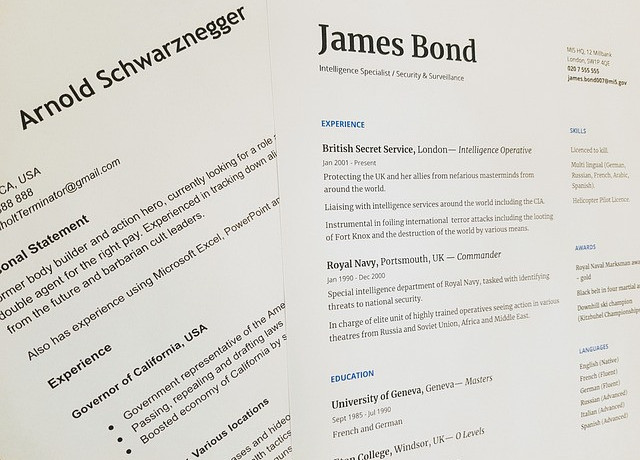Why Your Resume is Your Golden Ticket
Have you ever considered how vital your resume is in your professional journey? Think of it as your golden ticket.
Your First Handshake with Employers
Before you walk into an interview or even get a callback, your resume speaks for you. It’s your initial handshake with potential employers, introducing them to what you offer. Every detail, from your past roles to your educational background, forms a narrative about your capabilities.
More Than Just a Document
Beyond mere qualifications, your resume is a reflection of your journey. Each line and bullet point tells a story about your experiences, your challenges, and the unique skills you’ve picked up along the way.
In the bustling world of job searches, your resume is the tool that carves out a space just for you.
The Origin Story of the Resume
Have you ever wondered where the concept of the resume began? It’s a tale worth telling.
From Leonardo to LinkedIn
Believe it or not, the idea of showcasing one’s skills and expertise isn’t new. Leonardo da Vinci, the Renaissance genius, is credited with penning the first resume in 1482. Instead of a LinkedIn request, he sent a letter to the Duke of Milan, detailing his many talents. Just like you, he wanted to land a job!
Evolving With the Times
As the centuries rolled on, the resume adapted. From handwritten notes to digital profiles, this document has mirrored societal and technological shifts. It has constantly reshaped itself, ensuring job seekers like you stay relevant in an ever-changing job market.
Not Just a Western Concept
And it’s not just a Western tradition. From the intricate “job scrolls” of ancient China to the career manuscripts of Renaissance Europe, various cultures understood the importance of professionally presenting oneself.
Diving into its history, you’ll realize the resume is not just a piece of paper. It’s a testament to your adaptability and evolution, just as it has evolved over time.
Unveiling the True Purpose of Your Resume
Ever stood back and gazed at your resume, wondering about its true essence? Let’s unwrap its core functions.
First Impression: The Power of First Glances
Your resume is the first impression you’ll ever make on an employer. Before they see your attire or hear your voice, they’ve already formed an opinion based on this document. Quite like how a book cover can entice readers, your resume’s design, layout, and content pull potential employers into your story. It’s your shot at making them think, “This is exactly who we’ve been searching for!”
Highlight Qualifications: Shine the Spotlight on Your Achievements
Have you considered your resume as your personal highlight reel? It’s where you spotlight your proudest moments. Each job position, every project completed, and every skill acquired gets its moment to shine. By meticulously curating these, you’re not just listing your qualifications—you’re telling potential employers, “Here’s why I’m your ideal candidate.”
Filtering Tool for Employers: Making Their Job Easier
On the flip side, while you use your resume to broadcast your achievements, employers use it as a filtering tool. With possibly hundreds of applications flooding in for a single position, they need a way to sift through the noise. Tailoring your resume to the specific requirements of the job can make a world of difference. It’s like crafting a key that perfectly fits the lock they’re trying to open.
Chronicle of Professional History: Your Career’s Storybook
Beyond the immediate task of job hunting, your resume serves as a chronicle of your professional journey. Flipping through its pages, you can trace your growth, see the challenges you’ve surmounted, and reminisce about the roles that shaped you. It’s a tangible timeline of where you’ve been and an inspiring hint of where you might go next.
Crafting a Resume That Serves Its Purpose
Now that we’ve explored its primary functions let’s turn to you. How can you ensure your resume serves its multifaceted purpose well?
- Prioritize Readability:
Use a clean layout, consistent fonts, and bullet points. Remember, if an employer struggles to find key information, they might just set your resume aside. - Be Authentic:
While it’s essential to tailor your resume, never exaggerate or misrepresent your qualifications. Your authenticity should shine through. - Use Action Words:
Instead of saying, “responsible for managing a team,” why not say, “led a 15-member team”? Action words give your achievements the punch they deserve. - Quantify Achievements:
When possible, add numbers. Instead of “increased sales,” you could specify “boosted sales by 20% in the first quarter.” - Keep it Updated:
Even if you’re not actively job hunting, it’s a good habit to update your resume periodically. Celebrate new skills and achievements by adding them promptly. - Proofread:
A resume free of typos and grammatical errors not only appears professional but also demonstrates your attention to detail.
In the realm of career advancement, your resume is a powerful ally. It’s the bridge between you and your dream job, a platform where you present your best self, and a reflection of your professional journey. While the task of crafting it might seem daunting, remember its significance. With every line you write, every skill you list, and every achievement you spotlight, you’re inching closer to your next big opportunity.
So, as you refine, revise, or even start from scratch, know that you’re sculpting a tool that will play a pivotal role in shaping your career. And if ever in doubt, return to its primary purposes. They’ll guide you, ensuring your resume isn’t just good, but outstanding.
Digging Deeper: The Unsung Roles of Your Resume
When we talk about resumes, the primary purposes might be clear, but have you ever considered the less obvious roles this document plays? Let’s dive into the secondary, yet equally impactful, functions of your resume.
Networking Tool: Your Pocket-sized Elevator Pitch
Imagine you’re at a professional gathering, mingling with industry leaders, and someone asks, “What do you do?” Sure, you could launch into a verbal summary, but handing them a well-prepared resume? Now, that’s making a statement. This document can act as a pocket-sized elevator pitch, offering a snapshot of your capabilities. And who knows? Today’s casual chat over cocktails could be tomorrow’s formal interview.
Personal Branding: The Essence of You
Brands aren’t just for corporations. Just as companies have logos and slogans, your resume serves a similar branding purpose for you. Through it, you’re communicating your professional identity, values, and niche expertise. It’s a canvas where you paint a picture of who you are in the professional world. Think about it: If someone only had your resume to go by, what impression would they form of you? It’s essential to ensure that impression is a memorable and positive one.
Confidence Builder: The Mirror Reflecting Your Worth
Have you ever taken a moment to step back and truly appreciate your accomplishments? Your resume is more than just a job-seeking tool—it’s a confidence booster. Each time you update it with a new achievement, it serves as a pat on the back, a reminder of how far you’ve come. Reading through your own career milestones can reignite your motivation and remind you of your value in the professional sphere.
Crafting a Resume with Secondary Purposes in Mind
While the primary purposes of a resume are undeniably crucial, weaving in these secondary objectives can elevate its effectiveness. How can you ensure your resume ticks these boxes too?
- Engage with a Personal Touch:
Consider adding a brief professional summary or statement. It gives a glimpse of your personality, making your resume stand out. - Maintain Consistency:
Ensure uniformity across all your professional documents and platforms, from LinkedIn to personal portfolios. This strengthens your personal brand. - Celebrate Small Wins:
Did you complete a short course? Or perhaps led a minor project to success? Include these. They not only add weight to your resume but also serve as reminders of your dedication. - Seek Feedback:
Sharing your resume with mentors or peers can offer fresh perspectives. Their inputs can help align your resume more closely with your personal brand. - Stay Current:
Just as industries evolve, so should your resume. Regularly update it, reflecting any new skills, tools, or methodologies relevant to your field. - Reflect and Refine:
Periodically, take a moment to review your resume. Celebrate your achievements, note areas of growth, and realign with your career goals.
Diving deeper into the roles your resume plays can be enlightening. It’s not just a gateway to job opportunities, but a dynamic tool that aids in networking, strengthens your personal brand, and bolsters your self-confidence.
In your professional journey, while it’s essential to look outward and forward, it’s equally vital to occasionally turn inward. Your resume is a tool that aids in this introspection. It’s a mirror that reflects your past achievements, a compass that can guide your future directions, and a beacon that can illuminate paths not yet taken.
So, the next time you hand out or email your resume, remember: You’re not just sharing a document. You’re extending an invitation to engage with your professional story, your brand, and your aspirations. It’s a multi-dimensional tool, and when wielded right, its impact can be truly transformative.
Crafting the Perfect Resume: A Deep Dive into Key Components
The world of job hunting is fiercely competitive. How do you ensure you stand out in a sea of potential candidates? Your resume, when crafted effectively, can be the magnet that draws an employer’s attention. Let’s dissect its anatomy and pinpoint the elements that make it truly captivating.
Contact Information: The Door to Your Professional World
Your resume could be a masterpiece, but it’s virtually useless if employers don’t know how to reach you. Always place your contact details—name, phone number, email, and possibly a LinkedIn profile—at the very top. It’s like planting a flag, saying, “Here’s where you can find me.”
Objective or Summary: Your Professional North Star
In a concise manner, convey your career goals and aspirations. Think of this as the elevator pitch for where you see your career trajectory. It immediately clues employers into what you’re aiming for, ensuring they know you’re aligned with the position in question.
Experience: The Chapters of Your Career Story
This is the meat of your resume. It’s where you detail the roles you’ve held, the organizations you’ve enriched, and the duration of each tenure. But don’t just list tasks; highlight achievements. Remember, it’s not just about where you’ve been, but the impact you made while you were there.
Education: The Foundations of Your Expertise
Your academic credentials serve as the backbone of your professional knowledge. Whether it’s a degree, diploma, or a certificate course, this section underscores the formal training that’s equipped you for the job world. And while it’s vital, ensure it aligns with the role you’re seeking.
Skills: The Tools in Your Arsenal
This section is your chance to list the specific tools, languages, techniques, and soft skills you possess. Are you a wiz with a certain software? Or maybe you have a knack for leadership? List these out, but be genuine—remember, you might need to back these claims up in an interview!
Optimizing for Impact: Making Every Word Count
A resume isn’t just about including the right information—it’s about presenting it in a manner that’s digestible, engaging, and reflective of your professionalism.
- Be Consistent:
Use uniform fonts, bullet points, and headings throughout. This consistency doesn’t just look good; it aids readability. - Prioritize Relevance:
Tailor your resume for the job you’re applying for. Highlight the experience and skills most pertinent to the position. - Use Action Verbs:
Phrases like “achieved,” “managed,” or “developed” can give your achievements the emphasis they deserve.
Your resume is more than just a document—it’s a testament to your professional journey. By focusing on these key components and presenting them effectively, you’re not only detailing your credentials but also telling a story of commitment, growth, and ambition.
And remember, as you navigate the job market, your resume is often your first impression. Make it count. With the right attention to detail and a focus on showcasing your unique value, you’re one step closer to landing that dream role.
Debunking the Myths: The Resume Edition
Ah, the world of resumes—rife with rules, traditions, and… misconceptions? That’s right! There are numerous myths surrounding this essential career document. Let’s clear the fog and address some of these commonly held but misguided beliefs.
Longer is Always Better: The Myth of Quantity
You might think the more extensive your resume, the more impressive it appears. Wrong! Hiring managers often prefer conciseness over pages of details. A crisp, well-tailored resume is your goal. You want to make an impact, and sometimes, less is more.
One Resume Fits All: The Universal Key Fallacy
Ever heard of the “spray and pray” approach? Sending the same resume for multiple roles can be tempting but is often ineffective. Each job has unique requirements. Thus, it’s crucial to tailor your resume to each specific position. Give each application its due diligence.
Fancy Designs Impress: The Over-Decorating Dilemma
A flashy design might catch the eye, but it can also distract. The content is king. Unless you’re in a field like graphic design, it’s best to keep the layout clean and simple. Remember, substance over style.
Listing Duties is Enough: The Task-Listing Trap
Many believe it’s enough to simply list job responsibilities. The real impact, however, comes from showcasing achievements. Instead of just detailing tasks, emphasize the results and value you brought to previous roles.
Errors are Okay, Content Matters: The Proofreading Myth
Never underestimate the power of punctuation and grammar! Even small errors can suggest a lack of attention to detail. Always proofread before sending. Your content is vital, but presenting it flawlessly is equally crucial.
In the vast landscape of career advice, it’s easy to get swayed by misconceptions, especially when they seem to be widely accepted. But remember, the world is ever-evolving, and so are the rules of resume writing.
Your resume is a reflection of you. It tells your professional story and showcases your value to potential employers. By steering clear of these myths and focusing on proven strategies, you’re ensuring that your resume not only gets noticed but also leaves a lasting impression. The next time you hear a piece of resume “wisdom,” pause, reflect, and see if it stands up to the test of reality.
Wrapping it Up: Navigating the Resume Journey with Precision
Navigating the intricacies of resume writing can often feel like treading through a maze. But with clarity, understanding, and a dash of dedication, you can turn this document into your best professional advocate.
A Resume is More Than Just a Document
Remember, your resume isn’t just a sheet of paper. It’s a culmination of your professional journey. It reflects your skills, achievements, and aspirations. When crafted with care and precision, it becomes your voice even before you step into an interview room.
Always Evolve and Adapt
Just as the professional world changes, so should your resume. Keeping it updated, tailored to each job, and free from common misconceptions ensures it remains relevant and impactful. Stay attuned to the pulse of your industry and adjust accordingly.
In conclusion, as you stand at the crossroads of countless opportunities, arm yourself with a well-crafted resume. It’s your passport to new beginnings, fresh challenges, and uncharted career territories. Take the insights, debunk the myths, and wield this tool with confidence. Your future awaits, and your resume is the ticket to get you there. Here’s to crafting not just a document, but a dynamic testament to your professional legacy. Best of luck on your journey ahead!
Additional Resources:
Here is a link to an online resume building: resume.io
Here is a linke to an article that discusses five other online resume tools: 5 Best Resume Builder Tools to Help You Get Your Next Job
Related Topics:
FAQ
What are three purposes of a resume?
A resume serves to present your qualifications, showcase your accomplishments, and provide a summary of your professional background to potential employers.
What is the purpose of a resume and CV?
While both documents highlight one’s professional background, a resume is concise and tailored for job applications, whereas a CV is a comprehensive record of one’s academic and professional achievements, typically used in academia or research.
What is a good resume?
A good resume is clear, concise, and tailored to the specific job, showcasing relevant qualifications and accomplishments. It’s also free from errors and uses a professional format.
What is the best skills for resume?
The best skills for a resume are those relevant to the job you’re applying for, including both hard skills (like software proficiency) and soft skills (like communication or teamwork).
What type of resume is most successful?
A reverse-chronological resume, which lists the most recent experiences first, is commonly successful as it showcases current skills and experiences at the top.
What does your resume say about you?
Your resume offers a snapshot of your professional journey, highlighting your skills, experiences, and achievements, thus revealing your expertise, work ethic, and areas of proficiency.
Who needs a resume?
Anyone seeking employment or professional opportunities, whether a recent graduate, a seasoned professional, or someone looking to change careers, needs a resume.
What are 4 things to remember when making a resume?
When making a resume, remember to 1) tailor it to the specific job, 2) highlight achievements, not just duties, 3) proofread for errors, and 4) use a clean, professional format.
Who needs a CV vs a resume?
A CV is typically needed by professionals in academia, research, or medicine, as it offers a detailed overview of one’s entire career. A resume, shorter and more tailored, is suitable for most other professions and job applications.




Leave a Reply